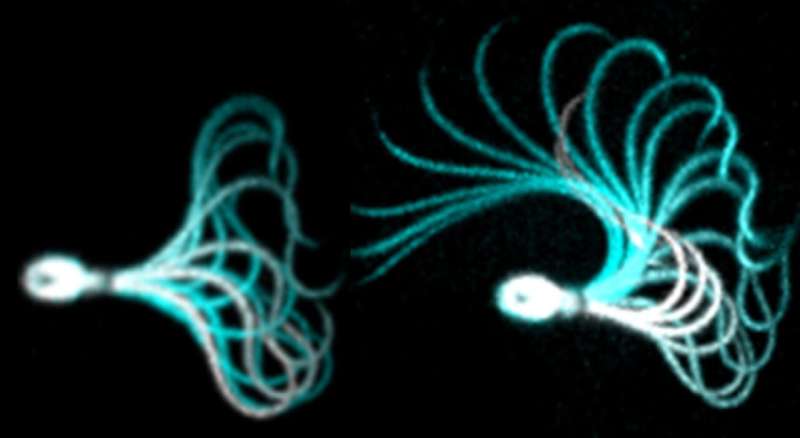This article has been reviewed according to Science X's editorial process and policies. Editors have highlighted the following attributes while ensuring the content's credibility:
fact-checked
peer-reviewed publication
trusted source
proofread
Study: Defective ion channel in sperm flagellum renders men infertile, affects medically assisted reproduction

In half of the couples that are unable to conceive a child, the infertility is due to the man. A new study identifies the defective function of "CatSper," an ion channel controlling calcium levels in sperm, as a common cause of seemingly unexplained male infertility.
CatSper-deficient human sperm fail to fertilize the egg, because they cannot penetrate its protective vestments. Thus far, this sperm channelopathy has remained undetectable.
Scientists from Münster, Germany, have unraveled CatSper's role in infertility using a novel laboratory test that identifies affected men. Based on the results of the study, which has been published in the Journal of Clinical Investigation, diagnostics and care of infertile couples can be improved.
One in six couples fail to conceive a child. The underlying cause often remains unresolved. In fact, in about one third of infertile couples, the man's semen analysis yields no abnormalities in the number, motility, or morphology of the sperm. This poses a problem: The lack of a clear diagnosis prevents an evidence-based selection of a therapy option. As a result, affected couples often experience unsuccessful treatments.
How do men fail to conceive a child despite normal semen parameters? An interdisciplinary team of scientists from the University of Münster in Germany, set out to answer this question. "For quite a while, we have considered CatSper a prime suspect," says Prof. Timo Strünker from the Center of Reproductive Medicine and Andrology (CeRA).
Some years ago, Strünker and colleagues revealed that sperm use CatSper as a sensor to detect messenger molecules released by the egg. These molecules activate CatSper, which leads to an influx of calcium into the flagellum, changing its beating pattern.
To scrutinize whether this is essential for fertilization, the researchers developed a simple laboratory test that enabled them to determine the activity of CatSper in sperm from almost 2,300 men. This revealed that about 1 in 100 infertile men with unremarkable semen parameters indeed feature a loss of CatSper function.
"The most common cause is genetic variants in genes encoding one of CatSper's components," adds Reproductive Geneticist Prof. Frank Tüttelmann, Münster.
Sperm require the changes in flagellar beating mediated by CatSper to break through the egg's protective coat. Another important finding of the study: CatSper-related male infertility also involves failure of medically assisted reproduction via intrauterine insemination, involving the application of sperm via a catheter into the uterus right before ovulation, or classical in-vitro fertilization (fertilization in the petri dish).
This is not surprising, considering that these treatments still require the sperm to break through the egg coat. Affected men/couples could only conceive a child via the ICSI method, which involves the manual injection of a sperm cell into the egg.
"Thanks to this comprehensive research endeavor, we can now identify and diagnose this channelopathy, enabling evidence-based treatment of affected couples," summarizes Prof. Sabine Kliesch, Head of the Department of Clinical and Surgical Andrology at the CeRA. "Thereby, we minimize the medical risk for the couples and maximize the chances of success."
The function of sperm is not only controlled by CatSper but also various other proteins. These are also in the focus of the Clinical Research Unit (CRU326) "Male Germ Cells," which provided the collaborative framework for the current study. The overarching aim of the researchers in Münster is to systematically elucidate the role of these proteins in (in)fertility, improving diagnostics and care of affected couples.
More information: Samuel Young et al, Human fertilization in vivo and in vitro requires the CatSper channel to initiate sperm hyperactivation, Journal of Clinical Investigation (2024). DOI: 10.1172/JCI173564

















